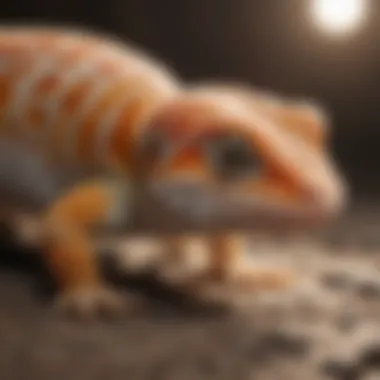Selecting the Optimal Substrate for Leopard Geckos: A Comprehensive Guide


Animal Species Profile
Leopard geckos, scientifically known as Eublepharis macularius, are fascinating reptiles that make popular pets due to their docile nature and unique appearance. These geckos are easily recognizable by their distinctive features, including their small size, a bumpy texture of the skin, and mesmerizing eyes. Originating from the arid regions of Afghanistan, Pakistan, and India, leopard geckos have evolved to thrive in dry, desert environments. Known for their solitary behavior, these nocturnal creatures are most active during the night, hunting for insects using their keen sense of smell and excellent eyesight.
Leopard geckos have a stoic presence, often found basking under heat lamps during the day to absorb warmth, while seeking shelter in hideouts to avoid predators. Their natural habitat consists of rocky terrains, where they can blend seamlessly with their surroundings to avoid detection. Despite their solitary nature, male leopard geckos can display territorial behavior, especially during mating season, where they compete for the attention of females through distinct vocalizations and physical displays.
Understanding the Importance of Substrate for Leopard Geckos
Choosing the right substrate for leopard geckos is a task that requires careful consideration and understanding. The substrate plays a crucial role in providing a suitable environment that mimics their natural habitat and promotes overall well-being. By focusing on specific elements such as safety, hygiene, and natural behavior facilitation, we can enhance the quality of life for these fascinating reptiles.
Role of Substrate in Leopard Geckos' Environment
Impact on Health
The impact of substrate on the health of leopard geckos cannot be overstated. Proper substrate selection directly correlates with the physical well-being of these creatures. A suitable substrate should offer the necessary support and cushioning to prevent injuries. Moreover, it should not harbor bacteria or parasites that could pose health risks. By providing a substrate that promotes cleanliness and comfort, we can significantly contribute to the overall health and vitality of leopard geckos.
Aiding Natural Behaviors
A crucial aspect of substrate selection is its ability to aid natural behaviors in leopard geckos. The substrate should allow for burrowing, a behavior essential for thermoregulation and comfort. Additionally, it should enable natural digging and foraging activities that stimulate physical and mental health. By choosing a substrate that supports these behaviors, we can create a more enriching environment for leopard geckos.
Temperature Regulation
Temperature regulation is another fundamental function of the substrate in a leopard gecko's enclosure. A suitable substrate should have adequate heat-retaining properties to create temperature gradients within the habitat. This ensures that leopard geckos can move between warmer and cooler areas to regulate their body temperature effectively. By selecting a substrate that assists in temperature control, we help maintain the optimal thermal conditions necessary for the well-being of these reptiles.
Factors to Consider When Choosing Substrate
Safety
Safety is paramount when selecting substrate for leopard geckos. The chosen substrate should be non-toxic, free from sharp edges or abrasive particles that could cause harm. Additionally, it should not contain any loose components that could be ingested and lead to digestive issues. Prioritizing safety in substrate selection is crucial to providing a secure and healthy environment for leopard geckos.
Hygiene


Hygiene is a key factor to consider when choosing substrate for leopard geckos. The substrate should be easy to clean and maintain to prevent the buildup of waste and bacteria. Moreover, it should offer good ventilation to minimize odor and moisture retention, creating a clean and hygienic habitat for the reptiles. By selecting a substrate that promotes cleanliness, we can reduce the risk of infections and ensure the well-being of leopard geckos.
Aesthetics
While aesthetics may seem like a secondary consideration, the visual appeal of the substrate can enhance the overall habitat design. An aesthetically pleasing substrate can contribute to the enrichment of the enclosure and create a more naturalistic environment for leopard geckos. Selecting a substrate that complements the aesthetic preferences of both the animals and their caretakers can elevate the visual appeal of the habitat.
Ease of Maintenance
Ease of maintenance is a practical aspect to evaluate when choosing substrate for leopard geckos. The substrate should be durable, long-lasting, and easy to spot-clean or replace. Additionally, it should not break down quickly or require frequent replenishment, as this can lead to added costs and disruptions to the habitat. Opting for a substrate that offers convenience in cleaning and upkeep simplifies the care routine for leopard geckos.
Relationship Between Substrate and Leopard Geckos' Well-being
Stress Reduction
The role of the substrate in stress reduction for leopard geckos is significant. A suitable substrate provides physical comfort and security, reducing stress levels in these reptiles. Additionally, a substrate that mimics their natural environment can create a sense of familiarity and safety, further minimizing stress responses. By choosing a substrate that promotes relaxation and comfort, we can help alleviate stress in leopard geckos.
Preventing Health Issues
Preventing health issues is a critical benefit of selecting the right substrate for leopard geckos. A clean and suitable substrate reduces the risk of infections, respiratory problems, and skin irritations. By maintaining good hygiene practices and opting for a substrate that supports health, we can prevent common health issues that may arise in captive leopard geckos.
Enhancing Activity Levels
The substrate plays a role in enhancing the activity levels of leopard geckos. A substrate that encourages natural behaviors such as burrowing, climbing, and foraging stimulates physical activity and mental engagement. By providing an enriching substrate that promotes exploration and movement, we can contribute to the overall well-being and vitality of leopard geckos.
Types of Substrate for Leopard Geckos
In this section, we will delve into the crucial topic of substrate choices for leopard geckos. The substrate plays a fundamental role in creating a suitable habitat that mimics the natural environment for these fascinating reptiles. Selecting the right type of substrate not only impacts their physical health but also influences their behaviors and comfort levels.
Loose Substrate Options
Sand
Sand stands out as a popular choice for leopard geckos due to its resemblance to their natural habitat. It mimics the sandy terrain where these geckos originate from, promoting a sense of familiarity and comfort. The texture of sand allows for natural burrowing behaviors, aiding in their thermoregulation and providing enrichment opportunities. However, it is essential to note that while sand is aesthetically pleasing and functional, there are concerns about impaction risks if ingested. Careful consideration and monitoring are necessary when using sand as a substrate.


Soil
Soil, another common substrate choice, replicates the earthy environment where leopard geckos thrive. Its moisture-retaining properties help maintain appropriate humidity levels in the terrarium, crucial for their overall well-being. Soil facilitates digging and tunneling activities, fulfilling their natural instincts. Despite its benefits in creating a naturalistic setting, soil may require frequent replacement or spot cleaning to prevent bacterial growth and maintain hygiene.
Coconut Fiber
Coconut fiber is a versatile substrate option known for its moisture-absorbing abilities. It aids in regulating humidity within the enclosure, creating a comfortable microclimate for leopard geckos. The fibrous texture of coconut fiber encourages natural behaviors like digging and nesting. While coconut fiber is eco-friendly and mold-resistant, some gecko owners find it challenging to spot-clean due to its absorbent nature. Regular monitoring and adjustments are necessary to prevent excessive moisture accumulation.
Non-Loose Substrate Options
Reptile Carpet
Reptile carpet offers a convenient alternative to loose substrates, providing a soft and reusable surface for leopard geckos. It eliminates the risk of ingestion associated with loose particles while facilitating ease of cleaning. Reptile carpet is durable and can withstand frequent spot-cleaning and washing, ensuring a hygienic environment for geckos. However, proper maintenance and regular replacement are essential to prevent bacterial buildup and odor.
Paper Towels
Paper towels serve as a temporary or quarantine substrate for leopard geckos, offering a hygienic and disposable option. They are cost-effective and easy to replace, simplifying cleaning routines for gecko owners. While paper towels lack long-term sustainability compared to other substrates, they are highly absorbent and assist in monitoring gecko excretions for health assessment. Frequent changes are necessary to uphold cleanliness and prevent bacterial contamination.
Tiles
Tiles present a durable and low-maintenance substrate option for leopard geckos' enclosures. Their smooth surface facilitates easy cleaning and sanitization, reducing the risk of bacterial growth. Tiles provide a stable platform for geckos to walk on, aiding in nail wear and preventing pododermatitis. However, tiles do not offer burrowing opportunities like loose substrates, potentially limiting behavioral enrichment. Supplementing the enclosure with additional hides and climbing structures can enhance the geckos' environment and activity levels.
Best Practices for Substrate Maintenance
When it comes to maintaining the substrate for leopard geckos, meticulous attention to detail is paramount. Proper substrate maintenance is crucial for ensuring the well-being and health of these fascinating reptiles. By focusing on specific elements such as cleanliness, safety, and comfort, one can create an environment that closely mimics their natural habitat. Regular upkeep of the substrate not only promotes hygiene but also helps in regulating humidity levels and providing a conducive space for natural behaviors.
Cleaning and Replacing Substrate
Frequency of Cleaning
Addressing the frequency of cleaning the substrate is of utmost importance in maintaining a healthy enclosure for leopard geckos. Regular cleaning schedules help in preventing the buildup of harmful bacteria and parasites, which can pose risks to the geckos' health. By regularly removing waste, uneaten food, and shedding skin, one can maintain a clean and safe environment for the leopard geckos. This practice also aids in minimizing odors and ensuring a comfortable living space.
Signs of Substrate Replacement


Recognizing the signs that indicate the need for substrate replacement is essential for the well-being of leopard geckos. Signs such as mold growth, foul odors, or an accumulation of waste beyond the substrate's capacity signify the need for a substrate change. Replacing the substrate in a timely manner helps in preventing health issues and maintaining hygiene standards within the geckos' habitat. It is advisable to monitor the substrate regularly for any signs of deterioration or contamination to ensure a healthy living environment.
Sanitization Methods
Implementing effective sanitization methods is key to promoting a clean and safe substrate environment for leopard geckos. Utilizing pet-safe disinfectants and cleaning agents, one can eliminate bacteria and pathogens that might be harmful to the geckos. It is important to choose sanitization methods that are non-toxic and suitable for reptile habitats to prevent any adverse effects on the geckos' health. Regular sanitization routines help in maintaining a hygienic substrate, thereby reducing the risk of diseases and ensuring the well-being of the leopard geckos.
Monitoring Humidity Levels
Use of Hygrometer
Monitoring humidity levels within the leopard geckos' enclosure is critical for their health and well-being. A hygrometer, a device used to measure humidity, assists in keeping track of moisture levels to ensure they fall within the recommended range for leopard geckos. Maintaining optimal humidity levels is essential for aiding in shedding, digestion, and overall comfort for the geckos. By utilizing a hygrometer, one can assess and adjust humidity levels as needed to create a suitable habitat for these reptiles.
Misting Techniques
Incorporating proper misting techniques is vital for maintaining adequate humidity levels in the geckos' enclosure. Misting helps in creating a humid environment, particularly essential during shedding periods when geckos require higher moisture levels. By spraying water onto the substrate and surfaces within the enclosure, one can simulate a natural humid environment that benefits the geckos' skin health and hydration. Care must be taken to avoid over-misting, which can lead to excessive humidity levels and potential respiratory issues.
Tips for Enhancing Substrate Efficiency
Providing Hiding Spots
Offering hiding spots within the enclosure is essential for ensuring the well-being and security of leopard geckos. Hiding spots provide geckos with a sense of security and privacy, reducing stress levels and promoting natural behaviors such as hiding and resting. By strategically placing hiding spots throughout the enclosure, one can create a diverse and engaging environment that caters to the geckos' natural instincts.
Adding Enrichment Elements
Introducing enrichment elements into the geckos' habitat is a great way to enhance their physical and mental stimulation. Enrichment elements such as climbing structures, basking platforms, and sensory toys offer geckos opportunities for exercise, exploration, and behavioral enrichment. These elements help in preventing boredom, promoting physical activity, and enhancing the overall well-being of leopard geckos. By incorporating enrichment elements into the enclosure, one can create a dynamic and engaging living space that supports the geckos' physiological and psychological needs.
Conclusion
In concluding this comprehensive guide on Choosing the Best Substrate for Leopard Geckos, it is paramount to underscore the critical role of substrate selection in ensuring the well-being and health of these fascinating reptiles. By carefully considering the diverse factors such as safety, hygiene, and the replication of their natural habitat, we can create an environment that promotes their overall welfare and contentment. Optimal substrate choice goes beyond mere aesthetics; it directly impacts the physical and psychological health of leopard geckos. Therefore, a judicious approach to substrate selection is imperative to enhance their quality of life.
Ensuring Optimal Substrate Choice for Leopard Geckos
Balancing Functionality and Comfort
When contemplating the significance of Balancing Functionality and Comfort in the context of leopard gecko care, it becomes evident that this specific aspect plays a pivotal role in determining the suitability of the substrate. Balancing Functionality and Comfort entails prioritizing the practicality of the substrate for the gecko's activities while ensuring a comfortable environment for them to thrive in. The key characteristic of Balancing Functionality and Comfort lies in its ability to provide an environment that supports natural behaviors while also offering a cozy retreat for the geckos. This balance is crucial as it allows them to exhibit their instinctual behaviors while feeling secure and at ease within their habitat. The unique feature of Balancing Functionality and Comfort is its ability to enhance the overall well-being of leopard geckos by striking a harmonious equilibrium between their need for stimulation and relaxation. This balance not only fosters physical health but also contributes to their psychological satisfaction, making it a popular choice among seasoned gecko owners.
Continuous Observation and Adjustment
In the realm of leopard gecko care, no facet is more critical than Continuous Observation and Adjustment. This aspect is indispensable for ensuring that the chosen substrate continues to meet the geckos' evolving needs over time. The key characteristic of Continuous Observation and Adjustment is its proactive nature, which involves consistently monitoring the geckos' interaction with the substrate and making necessary modifications to optimize their living conditions. This continual process allows caregivers to stay attuned to any changes in the geckos' behavior or health that may indicate a need for substrate adjustment. The unique feature of Continuous Observation and Adjustment is its adaptability, enabling caregivers to fine-tune the substrate based on specific requirements or preferences of individual geckos. While the advantages of this approach are evident in promoting the well-being of leopard geckos by adapting to their dynamic needs, it also requires diligence and attentiveness to ensure that the substrate remains conducive to their health and happiness.







